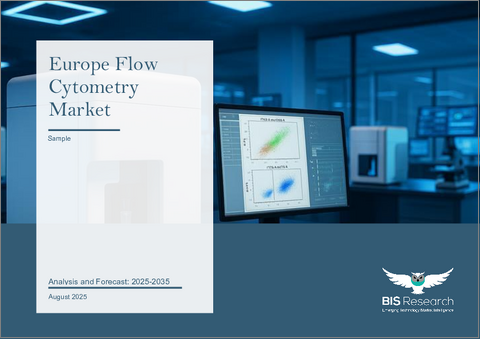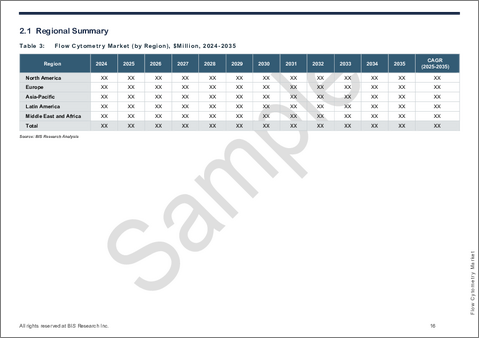|
|
市場調査レポート
商品コード
1794370
欧州のフローサイトメトリー市場:分析と予測(2025年~2035年)Europe Flow Cytometry Market: Analysis and Forecast, 2025-2035 |
||||||
カスタマイズ可能
|
|||||||
| 欧州のフローサイトメトリー市場:分析と予測(2025年~2035年) |
|
出版日: 2025年08月20日
発行: BIS Research
ページ情報: 英文 55 Pages
納期: 1~5営業日
|
全表示
- 概要
- 図表
- 目次
欧州のフローサイトメトリーの市場規模は、2024年の9億2,830万米ドルから2035年には20億4,570万米ドルに達し、予測期間の2025年~2035年のCAGRは7.53%になると予測されています。
欧州では、フローサイトメトリーは、懸濁液中の個々の細胞の詳細なマルチパラメトリー検査を可能にする基本的な分析技術として台頭してきました。同地域のバイオ医薬品開発、臨床診断、研究に不可欠です。腫瘍学、免疫学、感染症研究では、イムノフェノタイピング、細胞周期評価、バイオマーカー同定のような用途が広く使用されています。高スループットシステムとスペクトルフローサイトメトリーとの統合が進んでいることが、欧州の業界に大きな勢いをもたらしています。また、洗練された試薬や分析ツールの使用が増加していることや、個別化医療、細胞治療、遺伝子治療などが重視されるようになっていることも、需要を加速しています。このことは、フローサイトメトリーが欧州の精密ヘルスケアおよびライフサイエンス環境における重要な促進剤であることを立証しています。
| 主要市場統計 | |
|---|---|
| 予測期間 | 2025年~2035年 |
| 2025年の評価 | 9億8,940万米ドル |
| 2035年の予測 | 20億4,570万米ドル |
| CAGR | 7.53% |
市場イントロダクション
欧州のフローサイトメトリー市場は、臨床診断、ライフサイエンス研究、バイオ医薬品開発における需要の高まりにより、着実に成長しています。フローサイトメトリーは、細胞周期解析、バイオマーカー同定、イムノフェノタイピングなどの用途で頻繁に利用されています。免疫学、血液学、がん、感染症研究などの分野で、その重要性は増すばかりです。
スペクトルフローサイトメトリー、ハイスループット装置、AIを駆使したデータ解析の開発によってもたらされた精度の向上と使いやすさの向上が、臨床や研究での幅広い利用を支えています。診断手順におけるフローサイトメトリーの使用は、特に血液悪性腫瘍、免疫疾患、移植適合性の監視のために欧州諸国で拡大しています。また、ワクチン開発、細胞・遺伝子治療、オーダーメイド医療への関与が高まっている結果、市場も拡大しています。
この地域は、強力なヘルスケアインフラ、広範な学術研究ネットワーク、革新的な診断技術の革新と使用を奨励する有利な法的枠組みの恩恵を受けています。しかし、機器価格の高さ、データの解釈の難しさ、適格なオペレーターの不足は依然として大きな障害となっています。こうした障害にもかかわらず、フローサイトメトリー市場は、研究開発費の増加、戦略的産業提携、精密診断へのニーズの高まりにより、欧州全域で拡大が続くと予想されています。
地域別セグメンテーション
欧州
- 英国
- ドイツ
- フランス
- イタリア
- スペイン
- その他
欧州のフローサイトメトリー市場動向と促進要因・課題
市場動向
- 高パラメータ細胞解析のためのスペクトルフローサイトメトリーの採用増加。
- データ解釈とワークフロー自動化のためのAIと機械学習の統合。
- 免疫腫瘍学、幹細胞研究、感染症モニタリングにおけるフローサイトメトリーの用途拡大。
- 臨床診断、特に血液学と免疫不全症におけるフローサイトメトリーへの嗜好の高まり。
- 分散型ラボやポイントオブケアに適したコンパクトなベンチトップ型フローサイトメーターに対する需要の高まり。
主な市場促進要因
- がんや感染症の罹患率の増加が、高度な細胞解析の需要を促進。
- 欧州全域での創薬、トランスレーショナルリサーチ、臨床試験での使用拡大。
- 生物医学研究および診断技術革新に対する有利な規制支援と政府資金援助。
- マルチカラーアッセイ、セルソーティング、ハイスループット分析における技術進歩。
- 西欧および中欧における学術的・製薬的研究開発協力の拡大
主な課題
- 装置や試薬のコストが高く、小規模ラボや新興市場での利用が制限。
- フローサイトメトリーのデータ解析と操作に習熟した専門家の不足。
- ハイパラメーターサイトメーター別複雑なワークフローとデータ解釈の課題。
- 欧州各国における規制上のハードルと診断認可のばらつき。
- フローサイトメトリープラットフォームと病院やラボのITシステム間のデータ統合の問題。
製品/イノベーション戦略:欧州のフローサイトメトリー市場分析では、進化する研究および臨床ニーズに関する洞察を提供し、高パラメータ分析、スペクトル機能、臨床診断のための合理化されたワークフローなど、特定の要件に対応するフローサイトメトリー装置、試薬、ソフトウェアソリューションのカスタマイズ開発を可能にします。
成長/マーケティング戦略:このレポートは、学術研究、免疫腫瘍学、感染症診断などの主要セグメントや特定の地域機会に合わせたターゲットマーケティング戦略を実施し、顧客エンゲージメントを向上させ、普及を加速させる組織を支援します。
競合戦略:企業は、装置の拡張性、使いやすさ、試薬の互換性、アフターセールス・サポート、細胞治療やイムノフェノタイピングのような特殊用途など、ターゲット地域の最終ユーザーから特に評価されている特徴を強調することで、フローサイトメトリー製品を差別化することができます。
目次
エグゼクティブサマリー
第1章 市場:業界展望
- 欧州のフローサイトメトリー市場、市場規模(米ドル)、2024年~2035年
- 概要
- 主な調査結果
- 規制状況/コンプライアンス
- 欧州
- 市場力学
- 動向、促進要因、課題、機会:現状と将来の影響評価、2024年~2035年
- 動向
- フローサイトメトリーにおける継続的な技術革新
- フローサイトメトリー企業間のコラボレーション、戦略的パートナーシップ、アライアンスの増加
- 市場力学
- 市場の促進要因
- 市場の抑制要因
- 市場の機会
第2章 地域
- 地域のサマリー
- 成長シェアマトリックス
- 欧州
第3章 市場-競合ベンチマーキングと企業プロファイル
- 企業別製品ベンチマーク
- 競合情勢
- 各社の主要戦略と展開
- 企業プロファイル
- Merck KGaA
- Miltenyi Biotec
第4章 調査手法
List of Figures
- Figure 1: Europe Flow Cytometry Market (by Scenario), $Million, 2025 2030, and 2035
- Figure 2: Market Snapshot, 2024
- Figure 3: Flow Cytometry Market, $Million, 2024 and 2035
- Figure 4: Europe flow cytometry market, Market Size ($Million), 2024-2035
- Figure 5: Incidence of Cancer (by Region), Million, 2022, 2025, 2030, 2040, and 2050
- Figure 6: Key Drivers for Flow Cytometry's Role in Regenerative Medicine:
- Figure 7: Healthcare R&D Spending, $Billion, 2020-2023
- Figure 8: Key Applications in Infectious Disease Diagnostics
- Figure 9: Growth-Share Analysis for Flow Cytometry Market (by Region), 2024-2035
- Figure 10: Europe Flow Cytometry Market, $Million, 2024-2035
- Figure 11: U.K. Flow Cytometry Market, $Million, 2024-2035
- Figure 12: Germany Flow Cytometry Market, $Million, 2024-2035
- Figure 13: France Flow Cytometry Market, $Million, 2024-2035
- Figure 14: Italy. Flow Cytometry Market, $Million, 2024-2035
- Figure 15: Spain Flow Cytometry Market, $Million, 2024-2035
- Figure 16: Rest-of-Europe Flow Cytometry Market, $Million, 2024-2035
- Figure 17: Flow Cytometry Market, Product Benchmarking (by Company)
- Figure 18: Share of Key Strategies and Developments in Flow Cytometry Market, January 2020-May 2025
- Figure 19: Data Triangulation
- Figure 20: Top-Down and Bottom-Up Approach
- Figure 21: Assumptions and Limitations
List of Tables
- Table 1: Market Snapshot
- Table 2: Recent Technological Innovations in Flow Cytometry
- Table 3: Recent Strategic Activities Among Flow Cytometry Players
- Table 4: Flow Cytometry Instruments and Reagents in Regenerative Medicine
- Table 5: Price Comparison of Flow Cytometers
- Table 6: Flow Cytometry Market (by Region), $Million, 2024-2035
- Table 7: Europe Flow Cytometry Market (by Country), $Million, 2024-2035
This report can be delivered in 2 working days.
Introduction to Europe Flow Cytometry Market
The Europe flow cytometry market is projected to reach $2,045.7 million by 2035 from $928.3 million in 2024, growing at a CAGR of 7.53% during the forecast period 2025-2035. In Europe, flow cytometry has emerged as a fundamental analytical technique that allows for in-depth multiparametric examination of individual cells in suspension. It is essential to the region's biopharmaceutical development, clinical diagnostics, and research. In oncology, immunology, and infectious disease research, applications like immunophenotyping, cell cycle evaluation, and biomarker identification are extensively used. The increasing integration of high-throughput systems with spectral flow cytometry is driving significant momentum in the European industry. Demand is also being accelerated by the growing usage of sophisticated reagents and analytical tools, as well as by the growing emphasis on personalized medicine, cell and gene therapy, and more. This establishes flow cytometry as a crucial facilitator in the precision healthcare and life sciences environment in Europe.
| KEY MARKET STATISTICS | |
|---|---|
| Forecast Period | 2025 - 2035 |
| 2025 Evaluation | $989.4 Million |
| 2035 Forecast | $2,045.7 Million |
| CAGR | 7.53% |
Market Introduction
The flow cytometry market in Europe is growing steadily, owing to rising demand in clinical diagnostics, life sciences research, and biopharmaceutical development. Flow cytometry is frequently utilized in applications including cell cycle analysis, biomarker identification, and immunophenotyping because it allows for quick, multiparametric study of individual cells. In disciplines including immunology, hematology, cancer, and infectious disease research, its importance is only increasing.
Wider usage in clinical and research contexts is being supported by improvements in precision and usability brought about by developments in spectral flow cytometry, high-throughput equipment, and AI-powered data analysis. The use of flow cytometry in diagnostic procedures is growing in European nations, particularly for the surveillance of hematologic malignancies, immunological diseases, and transplant compatibility. The market is also growing as a result of its growing involvement in vaccine development, cell and gene therapies, and customized medicine.
The region benefits from a strong healthcare infrastructure, extensive academic research networks, and favorable legislative frameworks that encourage innovation and use of innovative diagnostic technology. High equipment prices, the difficulty of interpreting data, and a lack of qualified operators are still significant obstacles, though. Notwithstanding these obstacles, the market for flow cytometry is anticipated to continue expanding throughout Europe due to rising R&D expenditures, strategic industry partnerships, and the rising need for precision diagnostics.
Regional Segmentation
Europe
- U.K.
- Germany
- France
- Italy
- Spain
- Rest-of-Europe
Europe Flow Cytometry Market Trends, Drivers and Challenges
Market Trends
- Increasing adoption of spectral flow cytometry for high-parameter cell analysis.
- Integration of AI and machine learning for data interpretation and workflow automation.
- Expansion of flow cytometry applications in immuno-oncology, stem cell research, and infectious disease monitoring.
- Growing preference for flow cytometry in clinical diagnostics, especially in hematology and immunodeficiency disorders.
- Rising demand for compact, benchtop flow cytometers suitable for decentralized labs and point-of-care settings.
Key Market Drivers
- Rising incidence of cancer and infectious diseases fueling demand for advanced cellular analysis.
- Expanding use in drug discovery, translational research, and clinical trials across Europe.
- Favorable regulatory support and government funding for biomedical research and diagnostic innovation.
- Technological advancements in multi-color assays, cell sorting, and high-throughput analysis.
- Growing academic and pharmaceutical R&D collaborations in Western and Central Europe.
Major Challenges
- High instrument and reagent costs, limiting accessibility for smaller labs and emerging markets.
- Shortage of skilled professionals trained in flow cytometry data analysis and operation.
- Complex workflows and data interpretation challenges with high-parameter cytometers.
- Regulatory hurdles and variability in diagnostic approvals across European countries.
- Data integration issues between flow cytometry platforms and hospital or lab IT systems.
How can this report add value to an organization?
Product/Innovation Strategy: The Europe flow cytometry market analysis provides insights into evolving research and clinical needs, enabling organizations to develop customized flow cytometry instruments, reagents, and software solutions that address specific requirements such as high-parameter analysis, spectral capabilities, or streamlined workflows for clinical diagnostics.
Growth/Marketing Strategy: The report helps organizations implement targeted marketing strategies tailored to key segments such as academic research, immuno-oncology, or infectious disease diagnostics and specific regional opportunities, improving customer engagement and accelerating adoption.
Competitive Strategy: Organizations can differentiate their flow cytometry offerings by emphasizing features particularly valued by end-users in target regions, such as instrument scalability, ease of use, reagent compatibility, after-sales support, or specialized applications like cell therapy or immunophenotyping.
Table of Contents
Executive Summary
Scope and Definition
1 Market: Industry Outlook
- 1.1 Europe flow cytometry market, Market Size (US$), 2024-2035
- 1.1.1 Overview
- 1.1.2 Key Findings
- 1.2 Regulatory Landscape/Compliance
- 1.2.1 Europe
- 1.3 Market Dynamics
- 1.3.1 Trends, Drivers, Challenges, and Opportunities: Current and Future Impact Assessment, 2024-2035
- 1.4 Trends
- 1.4.1 Continuous Technological Innovations in Flow Cytometry
- 1.4.2 Increasing Collaborations, Strategic Partnerships, and Alliances among Flow Cytometry Players
- 1.5 Market Dynamics
- 1.5.1 Market Drivers
- 1.5.1.1 Rising Cancer Prevalence and the Growing Demand for Advanced Diagnostic Testing
- 1.5.1.2 Growing Use of Flow Cytometry in Regenerative Medicine
- 1.5.1.3 Growing Healthcare R&D Spending Fuels Adoption of Flow Cytometry Technologies
- 1.5.2 Market Restraints
- 1.5.2.1 High Cost of Acquisition
- 1.5.3 Market Opportunities
- 1.5.3.1 Increased Use in Clinical Applications and Infectious Disease Diagnostics
- 1.5.1 Market Drivers
2 Region
- 2.1 Regional Summary
- 2.2 Growth-Share Matrix
- 2.2.1 Europe
- 2.2.1.1 Regional Overview
- 2.2.1.2 Driving Factors for Market Growth
- 2.2.1.3 Factors Challenging the Market
- 2.2.1.4 Funding Initiatives and Grants
- 2.2.1.5 By Country
- 2.2.1.6 U.K.
- 2.2.1.7 Germany
- 2.2.1.8 France
- 2.2.1.9 Italy
- 2.2.1.10 Spain
- 2.2.1.11 Rest-of-Europe
- 2.2.1 Europe
3 Markets - Competitive Benchmarking & Company Profiles
- 3.1 Product Benchmarking By Company
- 3.2 Competitive Landscape
- 3.2.1 Key Strategies and Developments by Company
- 3.3 Company Profiles
- 3.3.1 Merck KGaA
- 3.3.1.1 Overview
- 3.3.1.2 Top Products/Product Portfolio
- 3.3.1.3 Top Competitors
- 3.3.1.4 Target Customers
- 3.3.1.5 Key Personal
- 3.3.1.6 Analyst View
- 3.3.1.7 Financial Analysis
- 3.3.2 Miltenyi Biotec
- 3.3.2.1 Overview
- 3.3.2.2 Top Products/Product Portfolio
- 3.3.2.3 Top Competitors
- 3.3.2.4 Target Customers
- 3.3.2.5 Key Personal
- 3.3.2.6 Analyst View
- 3.3.2.7 Financial Analysis
- 3.3.1 Merck KGaA
4 Research Methodology
- 4.1 Data Sources
- 4.1.1 Primary Data Sources
- 4.1.2 Secondary Data Sources
- 4.1.3 Data Triangulation
- 4.2 Market Estimation and Forecast






